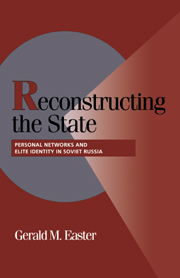Book contents
- Frontmatter
- Contents
- Preface
- 1 Introduction: Explaining State-Building Outcomes and the Soviet Russian Case
- Part I Structure and Identity in the Postrevolutionary State Elite
- 2 Anatomy of a Regional Elite: The Rise of the Provincial Komitetchiki
- 3 Constructing an Elite Identity: Images of Self, Service, and State
- Part II Informal Sources of Power in the Postrevolutionary State
- Part III Intrastate Conflict and the Constraints of Power Redefined
- Notes
- Bibliography
- Index
- Titles in the series
2 - Anatomy of a Regional Elite: The Rise of the Provincial Komitetchiki
Published online by Cambridge University Press: 13 October 2009
- Frontmatter
- Contents
- Preface
- 1 Introduction: Explaining State-Building Outcomes and the Soviet Russian Case
- Part I Structure and Identity in the Postrevolutionary State Elite
- 2 Anatomy of a Regional Elite: The Rise of the Provincial Komitetchiki
- 3 Constructing an Elite Identity: Images of Self, Service, and State
- Part II Informal Sources of Power in the Postrevolutionary State
- Part III Intrastate Conflict and the Constraints of Power Redefined
- Notes
- Bibliography
- Index
- Titles in the series
Summary
Who built the Soviet Russian state? While Western scholarship has produced a rich literature on leadership politics, organizational development and social processes, surprisingly few studies exist that direct attention to the state elites. Of the many excellent works on postrevolutionary politics, the first generation of state elites appear more often as supporting cast than as the focus of investigation. This study examines a select group of Bolsheviks, who, after the civil war, rose from the lower ranks of local administration to become the new state's first cohort of regional leaders. They are collectively referred to as the Provincial Komitetchiki. In the command chain of the postrevolutionary state, the Provincial Komitetchiki occupied the connecting link between the state center and the territorial political–administrative apparatus.
This chapter introduces the Provincial Komitetchiki. It sketches a collective biography, outlining the sociopolitical circumstances that influenced their formation and ascent to power. While the study marks the first focused investigation of the postrevolutionary regional leadership, it is by no means the first attempt to analyze the postrevolutionary state by investigating the center–regional relationship. Accordingly, the chapter begins with a brief survey and critique of the existing literature on center–regional relations and regional leaders. A second section discusses the rise of personal networks in postrevolutionary regional administration. This section is followed by an overview of intraparty cleavages and the power struggles of the 1920s.
- Type
- Chapter
- Information
- Reconstructing the StatePersonal Networks and Elite Identity in Soviet Russia, pp. 25 - 46Publisher: Cambridge University PressPrint publication year: 2000

